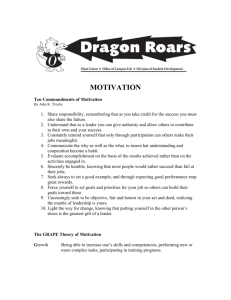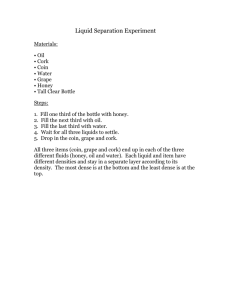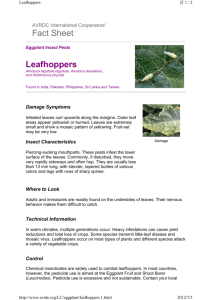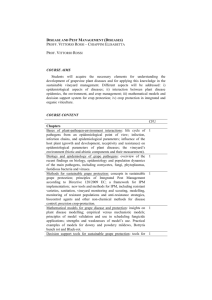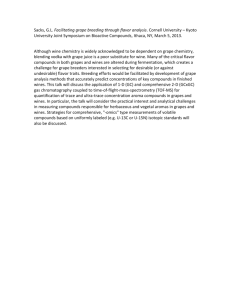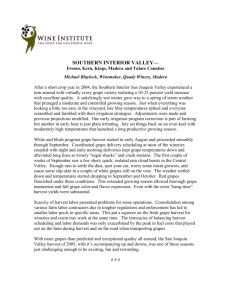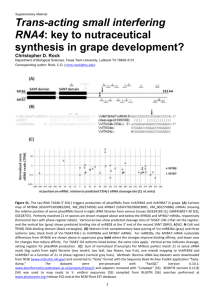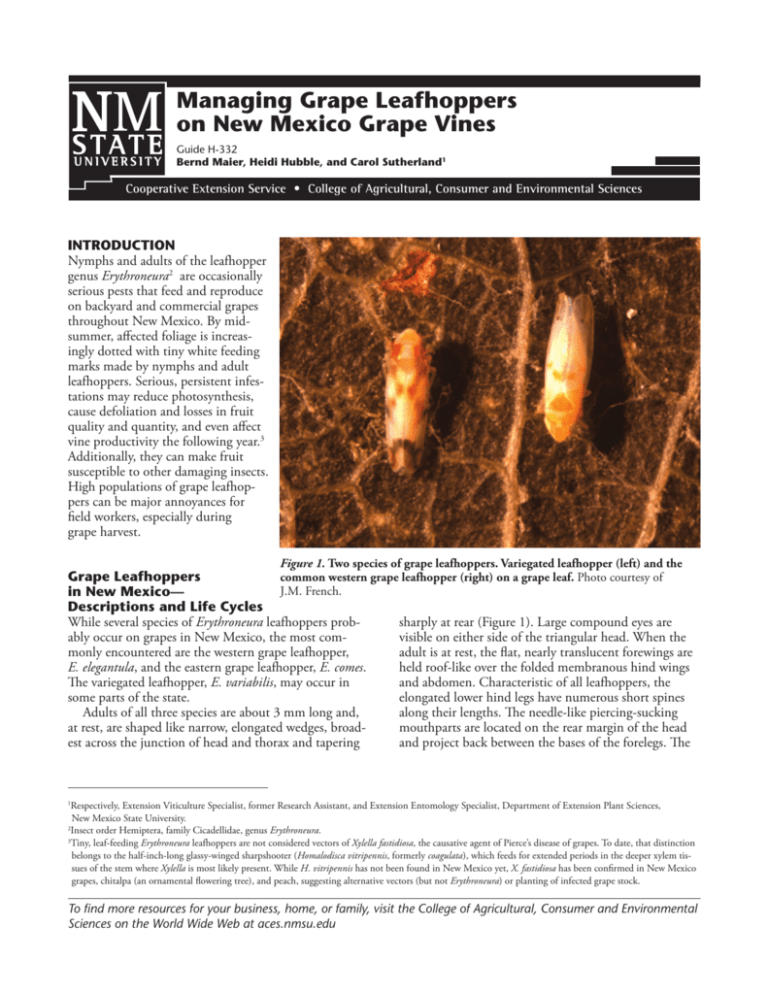
Managing Grape Leafhoppers
on New Mexico Grape Vines
Guide H-332
Bernd Maier, Heidi Hubble, and Carol Sutherland1
Cooperative Extension Service • College of Agricultural, Consumer and Environmental Sciences
INTRODUCTION
Nymphs and adults of the leafhopper
genus Erythroneura2 are occasionally
serious pests that feed and reproduce
on backyard and commercial grapes
throughout New Mexico. By midsummer, affected foliage is increasingly dotted with tiny white feeding
marks made by nymphs and adult
leafhoppers. Serious, persistent infestations may reduce photosynthesis,
cause defoliation and losses in fruit
quality and quantity, and even affect
vine productivity the following year.3
Additionally, they can make fruit
susceptible to other damaging insects.
High populations of grape leafhoppers can be major annoyances for
field workers, especially during
grape harvest.
Figure 1. Two species of grape leafhoppers. Variegated leafhopper (left) and the
Grape Leafhoppers
common western grape leafhopper (right) on a grape leaf. Photo courtesy of
J.M. French.
in New Mexico—
Descriptions and Life Cycles
While several species of Erythroneura leafhoppers probsharply at rear (Figure 1). Large compound eyes are
ably occur on grapes in New Mexico, the most comvisible on either side of the triangular head. When the
monly encountered are the western grape leafhopper,
adult is at rest, the flat, nearly translucent forewings are
E. elegantula, and the eastern grape leafhopper, E. comes.
held roof-like over the folded membranous hind wings
The variegated leafhopper, E. variabilis, may occur in
and abdomen. Characteristic of all leafhoppers, the
some parts of the state.
elongated lower hind legs have numerous short spines
Adults of all three species are about 3 mm long and,
along their lengths. The needle-like piercing-sucking
at rest, are shaped like narrow, elongated wedges, broadmouthparts are located on the rear margin of the head
est across the junction of head and thorax and tapering
and project back between the bases of the forelegs. The
Respectively, Extension Viticulture Specialist, former Research Assistant, and Extension Entomology Specialist, Department of Extension Plant Sciences,
New Mexico State University.
2
Insect order Hemiptera, family Cicadellidae, genus Erythroneura.
3
Tiny, leaf-feeding Erythroneura leafhoppers are not considered vectors of Xylella fastidiosa, the causative agent of Pierce’s disease of grapes. To date, that distinction
belongs to the half-inch-long glassy-winged sharpshooter (Homalodisca vitripennis, formerly coagulata), which feeds for extended periods in the deeper xylem tissues of the stem where Xylella is most likely present. While H. vitripennis has not been found in New Mexico yet, X. fastidiosa has been confirmed in New Mexico
grapes, chitalpa (an ornamental flowering tree), and peach, suggesting alternative vectors (but not Erythroneura) or planting of infected grape stock.
1
To find more resources for your business, home, or family, visit the College of Agricultural, Consumer and Environmental
Sciences on the World Wide Web at aces.nmsu.edu
Hatchling nymphs are nearly
colorless miniatures of the
adults they will become, except
hatchlings are wingless. Nymphs
will spend the next two to four
weeks actively moving around
their grape leaf habitat, feeding intermittently and growing
and molting through five stages.
When disturbed, even the smallest of them run sideways rapidly,
usually jumping to safety. Like
the adults, nymphs have piercingsucking mouthparts and are restricted to a totally liquid diet of
plant sap drawn from individual
leaf cells; the cells are killed in
the process, resulting in a white
dot at each feeding site. Damage
is cumulative, resulting in a leaf
that looks like the green color has
been increasingly sand-blasted
(Figure 2).
Serious foliar damage and loss
Figure 2. Example of leafhopper damage on grape leaves: “light” (top left), “moderate” (top right), and “heavy” (bottom, center). Photo courtesy of J.M. French.
can affect fruit cluster quality
and quantity, which are especially
important to commercial producsmall size of the leafhopper and its mouthparts suit it for
ers. Exposed grape clusters can sunburn, take longer
feeding in individual leaf cells.
to develop color, develop abnormal coloration, or even
Adults of these three common species are basically
wither. Grapes or grape clusters may not reach full size.
creamy white with weakly defined yellow markings
Sugar accumulation and acid degradation are both reon the head, thorax, and forewings. The eastern grape
tarded due to lack of effective leaf area.
leafhopper is the palest of the three, while the varLeafhopper excrement, or honeydew, is also a liqiegated grape leafhopper is usually the darkest, with
uid and contains undigested sugars and excess water.
brown and green tones. Western grape leafhoppers are
Nymphs and adults spray their honeydew, resulting in
pale like E. comes, but have a few red dashes and dots
small shiny or sticky dots on the foliage. Light deposits
on their forewings.
of honeydew may be washed off fruit before eating or
The life cycles of all grape leafhoppers involve simple
processing, but heavier amounts can be increasingly atmetamorphosis, proceeding from eggs through a series
tractive to bees, wasps, flies (both filth and fruit-feeding
of five active nymph stages to adults. Depending on
species), and fruit-feeding beetles. When humidity
temperatures and elevations, grape leafhoppers may have
is high, honeydew can sustain growth of sooty mold,
two to three generations annually.
which blackens fruit and foliage. Affected foliage will
As soon as foliage appears in the spring, adult females
fall from the vine.
are ready to feed and lay eggs. The female extends her
Leafhopper nymphs molt as they mature, leaving
saber-like egg-laying appendage (an “ovipositor”) to
their cast skins stuck on the undersides of the foliage.
puncture the leaf epidermis and inject her eggs individuNeither the nymphs nor these delicate skins should be
ally between the upper and lower surfaces of the leaf.
confused with whiteflies, which are entirely different
Freshly laid eggs are sausage-shaped, about 0.8 mm
insects. Short wing pads will be visible on the thorax of
long, and colorless. Eggs hatch in one to two weeks.
the largest nymphs; these are non-functional until the
With high pest pressure, eggs may be laid side by side in
insects molt to adults. Colors and color patterns on the
single layers between the larger veins on the leaf blades;
nymphs may be helpful in distinguishing some species
extensive damage can cause defoliation even before the
of Erythroneura. Western and eastern grape leafhoppers
leaves expand to full size.
transition from nearly colorless to white with yellow
Guide H-332 • Page 2
patches on the body by the fifth nymphal stage. Variegated grape leafhoppers become progressively darker
with each molt, changing from semi-transparent to light
yellowish-orange to mottled brown with developing
patterns of green, white, and red by the fifth nymphal
stage. Noting these subtle differences may be important for commercial growers in determining whether or
when to control grape leafhoppers (see following sections on pest management).
In spring and summer, grape leafhoppers mate soon
after becoming adults, the life cycle begins again, and
populations increase. Adults produced in spring and
summer probably survive two to three months. However, as day lengths and temperatures decrease in late
summer and early fall, the last generation of grape
leafhoppers enters diapause, a physiological state that
reduces metabolic rates, suppresses reproduction, and
permits the insects to survive several months on stored
body fat during the winter when no fresh grape foliage
is available. Diapausing adult grape leafhoppers usually
overwinter in tangles of weeds, grasses, fallen leaves,
mulches, and other ground debris in and around vineyards or backyard growing areas.
As temperatures increase in the spring and foliage
appears on host plants, surviving adult grape leafhoppers emerge from diapause and their overwintering sites.
They are relatively strong fliers and may fly for some
distance to find suitable host plants, including newly
transplanted grapes. Adults feed and mate and females
deposit their eggs, starting a new round of generations.
Natural Enemies of Grape Leafhoppers
Various natural enemies can suppress grape leafhopper
populations to some extent, although it may not be
enough to prevent economic damage, especially in commercial vineyards.
Predators of grape leafhoppers include a variety of
spiders, green lacewings, some lady beetles, big-eyed
bugs, assassin bugs, predatory stink bugs, predaceous
mites, and others. Different life stages of some of these
will prefer leafhopper eggs, while others are more effective on certain stages of the nymphs or adults.
A tiny wasp, Anagrus sp. (Hymenoptera, Mymaridae), may parasitize the eggs of western grape leafhoppers in New Mexico, particularly later in the growing
season. Approximately the same size as an Erythroneura
egg, the female wasp taps leaf surfaces with its antennae
to locate host material. She injects her egg through the
leaf epidermis into the leafhopper egg. The developing
wasp grub kills the leafhopper by feeding inside its egg.
The wasp grub pupates inside the remains of the egg and
emerges as a new adult wasp within a few weeks. Actively parasitized leafhopper eggs turn brick red briefly.
These wasps are totally harmless to humans and are not
likely to be seen by the casual observer.
Integrated Pest Management of
Grape Leafhoppers
While it can be defined in various ways for different
crops and situations, integrated pest management (IPM)
is an effective and environmentally sensitive approach to
managing pests that relies on combinations of commonsense, basic practices. For grape growers, awareness of
the life cycles and damage potentials of pests like grape
leafhoppers and their interactions with the crop environment are important components for building an
IPM program. Certain cultural, physical/mechanical,
biological, and chemical means of manipulating crops
like grapes and various pests like leafhoppers should be
considered by homeowners and commercial producers
alike. Practices that are feasible, economical, effective,
fairly compatible, and least hazardous to people, property, and the environment are most desirable. Some of
the following recommendations will be practical for all
producers to incorporate, but others are more applicable
to commercial growers.
For Homeowners
Select grape varieties that potentially will grow and
produce well in your area. Plant and support vines in
the sunniest area of the yard. Water vines adequately
throughout the year. Avoid over-fertilization of grape
vines since that can favor population development of
more pests than just leafhoppers. Learn to prune vines
properly. Remove fallen leaves, weeds, and other ground
debris from the vicinity of grape vines, reducing harborage for pest insects. Reasonably healthy, properly
maintained vines can tolerate some pest damage without
major fruit quality or vine health problems.
Learn to identify different life stages of grape pests
and beneficial arthropods that occur throughout the
year. Take samples of unfamiliar insects promptly to
your county Extension agent for identification.
Grape leafhoppers are easily able to outstrip the feeding and reproductive capacities of any of their natural
enemies. Check the health and status of vines and fruit
at least weekly during the growing season. If damage
reaches unacceptable levels, insecticides may be needed
to protect the vines and grape crop.
Backyard growers will find a variety of insecticide
products formulated for their specific needs at nurseries,
Guide H-332 • Page 3
garden centers, and discount and home improvement
stores. Spend time critically reading labels. Those with
both “grape” and “leafhoppers” on the label are good
candidates. Those products not labeled for either the
crop or the pest are likely not good candidates; they
may not be effective against the pest or they could cause
harm to the plant or its fruit. Note that some products
are labeled “ready to use” and are appropriate for small
jobs; these products are often sold with their own applicators. Other products are concentrates suitable for
dilution and larger jobs; these require purchase of an appropriate, reusable applicator. Products appropriately labeled for the backyard grower may include one or more
of the following active ingredients: pyrethrins, various
pyrethroids, imidacloprid, carbaryl, and malathion.
Regardless of the active ingredient or formulation,
follow all directions for safe, effective application and
storage. Pay special attention to when a treated area
may be re-occupied by pets or children. The label will
state how often the product may be reapplied and the
amount of time required to lapse, if any, between the
last application and grape harvest.
For Organic Growers
Certified organic grape producers can plan or modify
their own IPM programs using other appropriate practices outlined in this publication. However, according to requirements in the National Organic Program Final Rule,
certified organic producers must demonstrate to their
certifiers that they have exhausted all alternative means of
controlling a pest before requesting approval to apply an
appropriately labeled “OMRI Approved” insecticide.
Two pyrethrin formulations are currently registered
in New Mexico and meet OMRI4 standards.
For Commercial Growers
Many factors determine if grape leafhopper populations
are economically significant in any given year. These
could include grape variety selections, canopy features,
natural enemy activity, weather conditions, time of
season, vineyard layout and locality, types of crops or
non-crop areas surrounding the vineyard, and general
vineyard maintenance. Regular and frequent scouting
for pests in vineyards is essential.
Cultural Control
1. Variety selection. Early maturing varieties of grapes may
sustain less fruit damage than late maturing varieties.
2. Weed control. In late winter and early spring, tilling
weeds and other debris in the production area also
reduces harborage for overwintering leafhoppers.
Tilling done early in the morning when temperatures
are cooler may destroy more overwintering leafhoppers than later in the day when the insects can be
more active.
3. Canopy management. Some growers remove the
basal leaves on their vines during the first generation
of grape leafhoppers to reduce pest numbers later in
the season. Remember that removing too many leaves
may result in sunburned fruit.
4. Fertilizer management. Like other insects, grape
leafhoppers may prefer and flourish on vines that are
over-fertilized.
5. Sanitation. Eliminating fallen foliage and other debris in and around the production area reduces harborage for overwintering leafhoppers.
Scouting Routine
Guidelines have been developed for commercial growers to estimate grape leafhopper populations and set
potential treatment thresholds. Basically, ONLY the
nymphs are counted on selected leaves in sites scattered
around the vineyard; do not count cast skins or adults.
Remember that the nymphs are wary and will likely run
sideways across the leaf as soon as the leaf is turned over.
With a little practice, sampling the vines and recording
data will become quicker and easier to do. Growers are
also able to check on the progress of the crop and make
notes on other problems and their locations in the vineyard. Consider the following protocol to get reasonably
reliable results.
1. The best time to begin sampling the vines for leafhopper nymphs should be three to four weeks after
bud break or when nymphs begin to appear on
basal leaves.
2. For relatively small vineyards, sample the entire vineyard as one block. For larger properties where different varieties are planted in large blocks or where
blocks are in different locations, consider sampling
each block separately.
3. While sampling and counting are important, so is
RECORDING all of your counts. Create a permanent data table for each block and transcribe results
OMRI = Organic Materials Review Institute
4
Guide H-332 • Page 4
from each scouting date either on paper or on a computer software program. A pictorial graph of results
by block over time may be helpful in determining
trends in pest populations as well as the impacts various control measures might have.
4. Counts should be done weekly and analyzed promptly as described in step 3.
5. When sampling in the vineyard or block, first select a
“starting row” and then sample every fifth row from
there. Avoid end rows and four or five vines from
the ends of rows during the sampling process. Walk
down the sample row, choose a vine, turn over a leaf,
and quickly count JUST the nymphs. Record the location and count, do it again on a second leaf on the
same vine, and then repeat the sampling process (two
sample leaves/chosen vine) for every 10 to 20 vines
down the row.
NOTE: In the spring, adults emerging from overwintering sites will lay eggs on the more mature six
to eight basal leaves on the vines. This is most likely
where the first generation nymphs will be found
in the beginning of the season and also where leaf
samples should be taken. From mid to late season,
the 2nd and 3rd generation nymphs will be found
mostly in the middle of the canes; this is the area for
sampling leaves.
6. Select leaves at random to get a better representation
of population numbers. During the summer, nymphs
prefer to feed on the interior leaves of the canopy. If
only outer leaves are sampled, nymph populations
may be missed or underestimated.
7. NOTE: If western and variegated grape leafhoppers
occur in a vineyard, it may be worthwhile to keep
separate counts of each species, if possible. The tiny
egg-parasitic wasp, Anagrus sp., may destroy more
eggs of western grape leafhoppers than those of
variegated leafhoppers; the small wasp and its short
ovipositor can successfully reach the superficially
laid eggs of the western grape leafhopper but not the
deeper ones of the variegated species. By keeping the
counts separate and comparing them over time, the
presence of the wasp might be indicated indirectly.
Treatment decisions could still be made accurately
based on actual numbers of pests.
8. To determine the need for insecticidal control of
grape leafhoppers, calculate the average number of
nymphs per leaf for each block on each sampling
date. That is, for each data set for a block, add the
total number of nymphs counted and divide by the
number of leaves sampled. According to recommendations in California publications, an average of more
than 20 leafhopper nymphs per leaf with no indication of natural enemies present may justify treatment.
Depending on local New Mexico conditions, commodity prices, and grower experience, a treatment
threshold may be higher or lower than 20 nymphs
per leaf.
Chemical Control
If grape leafhopper populations are creating unacceptable damage despite cultural practices and biological
control, then chemical control may be necessary. Table 1
lists a variety of active ingredients and modes of action
for various insecticides. Some are contact insecticides,
some are systemic, and others are insect growth regulators. While some insecticides work well on both nymphs
and adults, insect growth regulators, in particular, are
effective only on immature stages. While most labels
state a product will control a given pest when used as
directed, others show “suppression only.” Generally,
if economically damaging leafhopper populations are
present, the best time to apply an insecticide should be
during the second generation nymph stage, approximately mid-July. Continue to monitor pest populations
after treatment to determine efficacy and also to determine if or when to make additional treatments; again,
follow label directions.
To prolong the efficacy of pesticides used for controlling grape leafhoppers or other grape pests, rotate
insecticides with different modes of action (MOA number) over the growing season. This reduces the selection
pressure on a pest population to become genetically resistant to a particular group of insecticides. To minimize
confusion and reduce technical jargon for growers and
applicators, the Insecticide Resistance Action Committee (IRAC) has simplified the expression of MOA to a
set of numbers from 1 to 28. The MOA number can be
found near the trade name of the insecticide on recently
printed product labels.
Before making any pesticide treatment for grape leafhoppers, carefully read the product label. Determine the
“re-entry interval” (REI) as well as any personal protective equipment (PPE) needed for application or followup field work. Adjust sampling dates and field work as
needed. Note the application details and date on your
data tables and determine changes in leafhopper populations post-treatment.
Guide H-332 • Page 5
Table 1. List of Registered Insecticides for Use on Grape and Grape Leafhoppers in New Mexico
Active Ingredient Mode of Action
G/R**
Notes
Carbaryl
1a
G
Carbamate, contact
Malathion
1b
G
Organophosphate, contact
Bifenthrin*
3a
R
Pyrethroid, contact
Beta-cyfluthrin
3a
R
Pyrethroid, contact
Cyfluthrin*
3a
R
Pyrethroid, contact
Fenpropathrin
3a
R
Pyrethroid, contact
Zeta-cypermethrin*
3a
R
Pyrethroid, contact
Pyrethrins
3a
G
Plant extract, 2 products lack the synergist piperonyl butoxide and are
OMRI-approved for commercial organic production; other commercial products with pyrethrins contain piperonyl butoxide and are NOT OMRI-approved for organic grape production.
Acetamiprid
4a
G
Neonicotinoid, contact, systemic
Dinotefuran
4a
G
Neonicotinoid, contact, systemic
Imidacloprid*
4a
G
Neonicotinoid, contact, systemic
Thiamethoxam
4a
G
Neonicotinoid, contact, systemic
Abamectin*
6
RContact
Fenpyroximate
21a
G
Contact, more effective on nymphs
Pyridaben
Indoxacarb
21a
22a
G
G
Contact, more effective on nymphs
Population suppression
*Some products contain only this active ingredient. Other products contain this and 1 or 2 other active ingredients.
**G = General use products (no applicator license required for purchase or use)
R = restricted use products (current pesticide applicator license required for purchase and use)
Table 1 summarizes information on approximately
75 products currently registered in New Mexico for use
on grape and grape leafhoppers. The active ingredients
are categorized as “general use” or “restricted use” (valid
NM Private Applicator license required for purchase and
use) along with appropriate MOAs. Growers are advised
that many products have only one active ingredient,
but they can also find products with two or occasionally
three active ingredients. Those with multiple active ingredients may be helpful in managing resistance in grape
leafhoppers when used in an insecticide rotation plan.
Bernd Maier is the Extension Viticulture
Specialist at New Mexico State University. He is a veteran of the New Mexico
viticulture industry with over 25 years of
experience in the state. His current research
includes meteorological studies and remote
sensing with respect to grape varieties for
Northern and Southern New Mexico, trellis system and irrigation evaluation to enhance grape quality, and mechanization.
REFERENCES
Daane, K.M., and M.J. Costello. 2000. Variegated
and western grape leafhoppers. In Raisin production
manual (pp. 173–181). Oakland: University of California.
Flaherty, D.L., L.P. Christensen, W.T. Lanini, J.J. Marois, P.A. Phillips, and L.T. Wilson (Eds.). 1992.
Grape pest management, 2nd ed. Oakland: University
of California.
New Mexico Department of Agriculture. 2012. New
Mexico pesticide information retrieval system
[Online]. Available from http://state.ceris.purdue.
edu/doc/nm/statenm.html
University of California. 2008. Grape leafhoppers
[Online]. Available from http://www.ipm.ucdavis.
edu/PMG/r302300111.html
Guide H-332 • Page 6
NOTES
Guide H-332 • Page 7
Disclaimer: The pesticide recommendations in this publication are provided only as a guide. The authors and New
Mexico State University assume no liability resulting from their use. Please be aware that pesticide labels and registration can change at any time; by law, it is the applicator’s responsibility to use pesticides ONLY according to the directions on the current label. Use pesticides selectively and carefully and follow recommended procedures for the safe storage
and disposal of surplus pesticides and containers.
Contents of publications may be freely reproduced for educational purposes. All other rights reserved. For permission to use
publications for other purposes, contact pubs@nmsu.edu or the authors listed on the publication.
New Mexico State University is an equal opportunity/affirmative action employer and educator. NMSU and the U.S. Department
of Agriculture cooperating.
March 2013
Las Cruces, NM
Guide H-332 • Page 8

